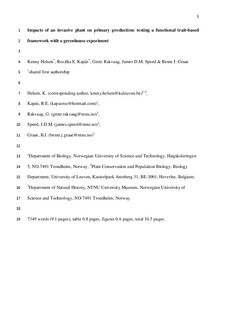| dc.contributor.author | Helsen, Kenny | |
| dc.contributor.author | Kapás, Rozália Erzsebet | |
| dc.contributor.author | Rakvaag, Grete | |
| dc.contributor.author | Speed, James David Mervyn | |
| dc.contributor.author | Graae, Bente Jessen | |
| dc.date.accessioned | 2019-03-28T12:55:37Z | |
| dc.date.available | 2019-03-28T12:55:37Z | |
| dc.date.created | 2018-10-16T20:50:17Z | |
| dc.date.issued | 2018 | |
| dc.identifier.citation | Journal of Vegetation Science. 2018, 29 (2), 157-166. | nb_NO |
| dc.identifier.issn | 1100-9233 | |
| dc.identifier.uri | http://hdl.handle.net/11250/2592237 | |
| dc.description.abstract | Questions
Predicting when invasive species will affect ecosystem functioning remains problematic, with strong contingency upon both the invasive species and the recipient community's identities. Adopting a functional trait‐based approach might overcome this context‐dependence. As an early exploration of this approach, we used a greenhouse experiment with seeds of the invasive plant Impatiens glandulifera to assess the potential invasion effects on community trait composition and biomass production.
Location
Three distant European seed origins, northern France, southern Sweden and central Norway, into transplanted turves from Trondheim, Norway.
Methods
At the end of the greenhouse experiment, we measured plant height, specific leaf area (SLA), leaf dry matter content (LDMC) and standing biomass of both the invasive plant and the turf communities. With these data we evaluated invasion effects on community trait composition and standing biomass (as a first test of ecosystem function effects), including dependence on invasive species origin and recipient community composition.
Results
Invasion by I. glandulifera introduced divergent trait values (high plant height and SLA, low LDMC) to the recipient community. The trait set of both the invader and, to a lesser extent, the community were altered following invasion, seemingly driven by increased light competition. Competitive and graminoid‐dominated communities showed stronger changes in LDMC following invasion. Functional traits of both the communities and the invasive species helped explain the increase in standing biomass. Southern invader plants more strongly affected the recipient community than their northern counterparts, resulting in stronger biomass reduction of the recipient community.
Conclusions
This study shows how invasion‐induced increases in productivity are effectuated through both the introduction of different invader traits and shifts in the co‐occurring species trait set, illustrating the potential of a functional trait‐based approach. | nb_NO |
| dc.language.iso | eng | nb_NO |
| dc.publisher | Wiley | nb_NO |
| dc.title | Impacts of an invasive plant on primary production: Testing a functional trait-based framework with a greenhouse experiment | nb_NO |
| dc.type | Journal article | nb_NO |
| dc.type | Peer reviewed | nb_NO |
| dc.description.version | acceptedVersion | nb_NO |
| dc.source.pagenumber | 157-166 | nb_NO |
| dc.source.volume | 29 | nb_NO |
| dc.source.journal | Journal of Vegetation Science | nb_NO |
| dc.source.issue | 2 | nb_NO |
| dc.identifier.doi | 10.1111/jvs.12619 | |
| dc.identifier.cristin | 1620908 | |
| dc.description.localcode | This is the peer reviewed version of an article, which has been published in final form at [https://doi.org/10.1111/jvs.12619]. This article may be used for non-commercial purposes in accordance with Wiley Terms and Conditions for Self-Archiving. | nb_NO |
| cristin.unitcode | 194,66,10,0 | |
| cristin.unitcode | 194,31,10,0 | |
| cristin.unitname | Institutt for biologi | |
| cristin.unitname | Institutt for naturhistorie | |
| cristin.ispublished | true | |
| cristin.fulltext | postprint | |
| cristin.qualitycode | 1 | |
